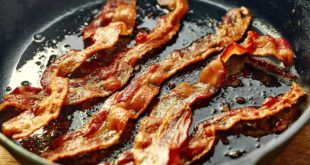
Earlier this year, Time magazine ran an article with the tag line: “Scientists labelled fat the enemy. Why they were wrong”. The story went on to suggest saturated fats aren’t as bad as previously thought and said that diet guidelines should be overhauled. Some scientists agreed, some didn’t, and we were left confused. So what exactly should we be eating in terms of fat?
Unfortunately, there’s no one defining answer everybody agrees on. We’re certainly emerging from a culture in which we were told that dietary fat was just plain bad and everything low fat was fabulous. We know trans fats should be avoided and aren’t likely to ever emerge from the unhealthy diet wasteland. We know omega-3 and omega-6 fats are good for us. Previously, we avoided saturated fats. But recent research suggests saturated fats – found in foods such as red meat and full-fat dairy foods – may not be the heart attack-inducers they were thought to be.
The bottom line is the human body needs fat. Not all fats are created equal when it comes to their impact on health and, as more research is showing, lumping them all into the same camp or trying to live a fat-free existence can be bad for your health.
The essential nutrients
Along with proteins and carbohydrates, fats are macronutrients that are essential for a whole lot of bodily functions, from providing energy, being shock absorbers for organs and transporting vitamins and other fat-soluble substances around the body.
Loosely speaking there are four types of fat: saturated from animals, including dairy; monounsaturated from nuts, seeds, olives and avocados; polyunsaturated, including the healthy omega-3 and -6 fatty acids; and the all-bad trans fats, which are found in highly processed deep-fried and commercially-baked packaged foods.
According to the Australian Heart Foundation, fat in all of its guises (except trans fats, ideally) should make up 20-35 per cent of our total daily calorie intake, with a maximum of 7 per cent of saturated fat. According to professor Manohar Garg, a leading health and nutrition researcher at the University of Newcastle who’s currently conducting an investigation that may shine more of a healthy light on saturated fats, it’s all about getting a combination of fats in our diet.
“It’s impractical and unnecessary to avoid saturated fats, but [we should instead] include a variety of fats in our daily diets,” Garg explains, adding that dietary fats shouldn’t be considered in isolation because when they work together they may actually be doing far more good than bad. “In fact, we’ve gone another step further to suggest that diets rich in saturated fats may, in fact, enhance the health benefits of omega-3 polyunsaturated fatty acids.”
Garg is one of a growing number of scientists worldwide who are no longer prepared to say saturated fats are bad and should be avoided at all costs. The study referenced in Time turned many previously held thoughts about fat on their head.
In that study, researchers at Cambridge University in the UK found that current evidence doesn’t support guidelines that restrict saturated fatty acid intake to reduce the risk of heart attack. In addition to that, they found the evidence doesn’t support the high consumption of the oft-lauded polyunsaturated “good fats” such as omega-3 and -6 for preventing cardiovascular problems.
The scientists even went as far as to say that dietary guidelines could be reappraised to reflect the growing body of evidence that indicates there’s no overall association between saturated fat consumption and heart disease.
The heart of the matter
The Heart Foundation, however, is still very much in the camp of saturated fats naysayers. “Eating too much saturated fat has been shown to raise the level of total cholesterol and low-density lipoprotein (LDL) cholesterol in your blood,” the foundation’s national cardiovascular health director, Dr Rob Grenfell, says. “High levels of LDL cholesterol, in particular, contribute to the build-up of fatty material, called plaque, on the inside of your blood vessels. These fatty build-ups can block the arteries and increase your risk of having a heart attack or stroke.”
He adds that there’s an “international scientific consensus” that replacing saturated fat with “good” unsaturated fat, in particular polyunsaturated fat, reduces the risk of heart disease.
Grenfell points out that this position is supported by the World Health Organization, other leading international heart associations such as the American Heart Association, the CSIRO and the Dietitians Association of Australia. It’s also consistent with the Australian Dietary Guidelines, which are based on a review of more than 700 studies. “To date, there hasn’t been sufficient evidence to warrant a change to our position,” he says.
So… hold the butter?
Accredited practising dietitian Kate Di Prima walks a moderate line on the fats debate. “If people are eating a healthy diet that’s rich in polyunsaturated and monounsaturated fats then a scrape of butter on their Vegemite toast isn’t going to hurt. In fact, evidence is showing that the body likes a combination of fats,” she says. “If you hate the taste of low-fat cheese or enjoy the occasional cappuccino with full-fat milk and are eating lots of fruit and veg and other healthy foods, then you don’t need to beat yourself up.”
Di Prima agrees that it’s a good idea to replace saturated fats with healthier fats, however, she also puts the debate into perspective: “Salmon is considered a very healthy fish that’s rich in good fats and we should all be eating more oily fish. However, 100g can also contain 5g of saturated fat and, ideally, we shouldn’t be consuming much more than 10g of saturated fat a day.
“And here the rules are challenged because a slice of cake may only have 4g of saturated fat – but what’s the healthier food option? It’s thesalmon, of course,” she adds. “We can’t benchmark individual foods according to only how much fat they have.”
“Low fat” doesn’t mean healthy
These days, so much of the food packaging in the supermarkets screams at us from the shelves that it’s “low fat” or “99% fat-free” – but don’t be fooled into thinking this means it’s better for you. Research has found that some low-fat foods contain the same number of calories, and sometimes more, than their full-fat cousins because of the extra sugars that are added to make up for the loss of taste and the poorer textures created when fat is removed.
“Low-fat diets lack satiety and may reduce good (HDL) cholesterol, counteracting any benefits of reduced bad (LDL) cholesterol,” Garg explains. “Low-fat diets may also reduce the absorption of fat-soluble essential nutrients such as vitamins A, D, E and K, as well as of [the powerful antioxidants] carotenoids such as lycopene and carotenes that protect the body against free radical damage.”
Fats at a glance
- Good vs bad fats
“Good” fats are monounsaturated fat (from olives, avocado), omega-3 polyunsaturated fat (from oily fish, walnuts and linseed) and omega-6 polyunsaturated fat (from fish, linseed, margarine, sunflower oil).
“Bad” fats are trans fats and, currently, saturated fats (from dairy and meat).
Fats should make up 20-35 per cent of our total daily calorie intake, with saturated fats making up just 7 per cent.
- What a day’s fat looks like
An active woman on 2000 calories a day can have about 65g of total fat, including up to about 15g saturated fat. This could be:
11/2 tbs olive oil
1 tsp margarine
1 handful almonds
1 egg
150g salmon
1 cup full-fat milk
Total fat: 65g Saturated fat: 13.8g
- The new research
Some scientists are saying that reducing saturated fats in the diet will not, in fact, prevent heart disease. They’re now calling for existing dietary guidelines regarding fats to be reviewed in light of these findings.
Source: bodyandSoul
 We are sharing information for knowledge. Presented by. SocialDiary.Net
We are sharing information for knowledge. Presented by. SocialDiary.Net



